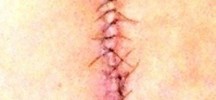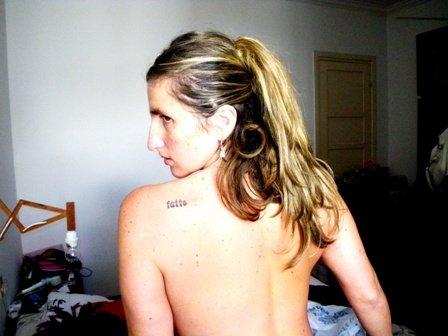In America alone, millions of people see the doctor every year for chronic back pain, and a large portion of them are left either temporarily or permanently disabled by the condition. According to a 2009 study on chronic low-back pain:
“Low back pain (LBP) is the second most common cause of disability in US adults and a common reason for lost work days.An estimated 149 million days of work per year are lost because of LBP. More than 80% of the population will experience an episode of LBP at some time during their lives.” (1)
For years, like most of those millions of people, I thought all I could do to prevent my discs pinching the sciatic nerve and sending me off to bed for weeks like an invalid was take pills, physical therapy and just rest it out until the pain subsided of its own accord.
Microdiscectomy
After years of these practices, they landed me on an operating room where the top neurosurgeon in my country performed a microdiscectomy. The operation is a microscopic procedure, where the section of the disc that has been herniated out of position and is pinching the nerve is literally sucked out of existence.
While the nerve will be released as a result, fibrosis and damage to the root of the nerve are an extremely common consequence of such operations. On the other hand, the disc is not being reconstructed, so there is a big chance of relapse, including the possibility of other discs becoming herniated in the long run.
People suffering from herniated discs are faced with different alternatives. Although the Mayo Clinic states on its webpage that back surgery is necessary in only a small percentage of cases, statistics show that back pain is the third most common cause of surgical procedures in the US (1).
Common surgical alternatives for herniated discs include:
- Discectomy. The removal of the herniated portion of a disc. It is done as open surgery and usually involves removal of the back portion of a vertebra to access the ruptured disk.
- Laminectomy Removal of the lamina — the back section of the vertebra over the spinal canal, thus decompressing the nerve.
- Microdiscectomy. Using a microscope to view the affected area, this procedure is a less invasive version of a discectomy, allowing the removal of disc portions with a smaller, less damaging incision.
- Artificial disks. A metallic artificial disk is implanted after removing the injured disks. Relatively new procedure with consequences still under study (2).
In my case, microdiscectomy was prescribed. However, nobody said anything to me about fibrosis, and how there was virtually no treatment for it, and it would only get worse with time. All they said was that I needed an urgent operation. The way my surgeon dealt with my reluctance to go under the knife was by saying that I was in risk of permanent paralysis; the bit of disc that was bulging out of place could get cut, fall and paralyze me from the pelvis down. That sealed the deal for me. Just like millions of people faced with the same dilemma every year all over the world, I thought I didn´t have any way out.
A chance meeting
Right before I got my operation, I was appointed to make a film about an athlete and physical exercise guru who does the decathlon at 75, and I realized that exercise had the power to keep a body healthy and young. The man, whose name was Raul, was a great inspiration for me in many ways.
After surgery, I was still in pain. The surgeon had me scanned once more, and he found out there was a bit of disc left inside me. So, they had to open me again. I believe that this second operation was what seriously damaged the root of my nerve. When the ozone therapy department head who had first sent me over to see the neurosurgeon saw my final scan, he exclaimed, “I wish I hadn´t sent you to get the operation. This is worse than before. You got horrible fibrosis.”
Post-surgery blues
Like every other patient who has been through herniated disc surgery, I had to take Gabapentin pills, which block out the pain in your nerve from reaching your brain; but the pain is still there. Meanwhile, I was swimming and cycling for 20 minutes at low speed in the gym; that was all the exercise doctors would allow me to do.

(Here you can read my poem A Prayer; a sort of No-ode to my surgeon & surgery)
Muscle power
But I had met a man who was doing the pole vault and 75, and had told me that there were muscles I could strengthen to fight the pain, the herniated discs, and the lot. So, one day, I had had enough of pills and lies, and of being unable to improve my body on account of my impossibility to take on a harder workout routine. So, I went to the trainers at my spa, and I told them I wanted to strengthen my back and my abs, without straining my lower back.
After four months of hardcore training carefully designed by experienced trainers, I lost about 14 pounds, built a lot of muscle, and started feeling much better. On the fourth month, I decided to stop taking the pills doctors said I would have to take every day for the rest of my life. I haven´t needed the pills, or seen a doctor for that matter, since that day.
Two months later, I feel stronger, my posture has improved, and I walk around in the gym carrying two 11-pound weights, when I used to have trouble carrying my laptop case. More importantly, I do not seem to be the exception to the rule, since a study showed that patients with low back pain who followed an exercise routine to strengthen all main muscle groups, combined with back care education, experienced a 40% reduction in reported days off work when compared to patients who weren’t working out (3).
What my experience has shown me is that the prevention of herniated discs would be much easier, if people would commit to an exercise routine as soon as they experience the first symptoms of back problems, and especially lower back pain.
Prevention, prevention
Once a disc is already herniated to the point that mine was, it is possible that you won´t be able to get away without surgery. But, even then, working these muscles will improve your posture and keep your vertebrae apart, so that your nerve won´t be pinched again, which is the main source of pain and movement inhibition in these cases.
There are countless studies all over the world trying to prove that lower back surgery works. There are also countless studies which demonstrate with the same eloquence that back surgery does more damage than good. Randomized controlled tests regarding the effects of exercise on lower back pain have largely been dedicated to mild stretching, motor control exercises (4), and the like; the results of which have typically not been very conclusive. It seems to me that it is time for researchers to devote more studies to the positive effects of hardcore physical exercise and muscle training, since this may be, after all, the only treatment for herniated discs that is 100% free of adverse effects.
WHERE TO START?
Here are some links with some exercise ideas and tips that might be useful. People keep emailing me for exercise tips after reading this post, hence this list. Hope it´s useful. Notwithstanding, my BEST ADVICE is find a sports medicine specialist or fitness expert with a profound knowledge of anatomy and spine problems. This can´t be just a regular fitness trainer, they need to have experience and serious University degrees. Only this type of person can guide you in your recovery, but it IS possible. Wishing you all good health for many years to come.
A playlist of exercises 2017
NOTE: The exercises in the playlist are not what people were recommending in Uruguay in 2010 when I first wrote this article. But they are the ones I find work best and make the most sense considering the anatomy of spine and discs.
Wisegeeks Exercises for herniated discs
Herniated disc exercises from NYTIMES Health
References:
1. Freburger JK, Holmes GM, Agans RP, Jackman AM, Darter JD, Wallace AS, Castel LD, Kalsbeek WD, Carey TS. The rising prevalence of chronic low back pain. Arch Intern Med. 2009 Feb 9;169(3):251-8.PMID: 19204216
2. Boos N, Aebi M, eds. Spinal Disorders: Fundamentals of Diagnosis and Treatment. New York, Berlin: Springer, 2008.
3. Klaber-Moffett J, Torgerson D, Bell-Syer S, Jackson D, Llewelyn-Phillips H, Farrin A, et al. Randomised controlled trial of exercise for low back pain: clinical outcomes, costs and preferences. 1999; 319:279-83.
4. Costa LO, Maher CG, Latimer J, Hodges PW, Herbert RD, Refshauge KM, McAuley JH, Jennings MD. Motor control exercise for chronic low back pain: a randomized placebo-controlled trial. Physical Therapy. 2009 Dec; 89(12):1275-86.PMID: 19892856

